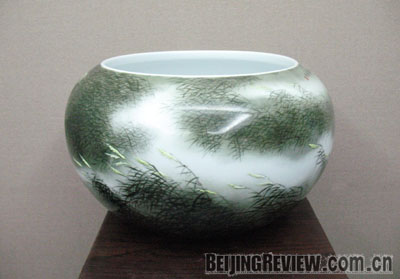 |
|
A contemporary porcelain artwork shown at an exhibition in Shanghai. |
Antique porcelain artifacts have long dominated the porcelain collection market, but the recent emergence of increasing numbers of counterfeit works and exorbitant prices are pushing collectors in a new direction. Enter contemporary porcelain artworks that experts say have a huge potential and less danger of being fake copies.
Market driven
Gao Su, Director of the Department of Porcelain Collection of the China International Association of Collection, said in the Beijing Times that compared with antique porcelain, contemporary porcelain has made many breakthroughs in craft, and because of new technology, some contemporary artworks are even better made than the antiques, both in color and design.
"The biggest problem for antique collectors are the rampant fake works in the market and ordinary collectors have to battle to find the real thing," said Gao.
He said another hurdle for ordinary collectors is the millions-of-yuan price tags attached to antique porcelain.
According to Gao, fake contemporary porcelain is seldom found, and the price is relatively low, which attracts investors.
"Today's first-class artworks might be tomorrow's rare treasures," Gao said.
His comments are borne out by the sales of contemporary porcelain works in auction houses. The market reaction to a spring sale at the China Guardian Auctions, a Beijing-based auction house, was encouraging.
"The successful sale has greatly promoted the status of contemporary porcelain art, and the market has shown the true value of art ceramics," Weng Li, General Manager of the Beijing Hebixing Craftwork Company, told the Beijing Times.
According to Weng, the contemporary porcelain, especially works of famous artists in Jiangxi Province's Jingdezhen, the porcelain capital of China that has a history of 1,700 years, has been gradually accepted by collectors and investors. Some prized pieces have been collected by museums and art institutions in other countries.
"The market value of contemporary porcelain art works is gradually rising by at least 20 percent each year," said Weng. Collectors predict this trend will continue in the next five to 10 years.
State-of-the-art
Traditional porcelain crafting has very specific areas of design. This allows each craftsman to become highly skilled in his area of expertise. From shaping and firing to painting, every part of the artwork requires a different pair of hands.
The emergence and development of the concepts and skills of contemporary porcelain art greatly challenge this tradition. The emergence of new porcelain-making machinery and the new skills based on modern technology means an artist can complete an artwork individually, from selecting the clays to molding and firing.
Thus, a contemporary porcelain work has more continuity of design, as only one creator is involved throughout the process. Today's collectors find this aspect more appealing than antique ones.
Currently, contemporary porcelain ark making in China is based on three major creative groups. One is the craftsmen in the traditional porcelain-making areas, one is those contemporary ceramists influenced by Western art concepts, and the other is artists who try to merge Western and Chinese cultural characteristics in their works.
How to invest
What makes a piece of porcelain valuable? According to Liu Yuanchang, an art expert, the value of art porcelain is made up of four aspects. The first is the art value of the work. Referring to the phenomenon in the market that a big work is normally priced higher than a small one, he said that only a work with high art value can expect big price increases.
Second is the crafting process. It basically takes 18 steps to finish a porcelain work. The process becomes more complicated if choosing the clay is included.
Third is that it should be associated with the time and reflect the time, which is also called the historic value of an artwork. Only a work that has both art value and historic value is worth investing in.
The last factor is the number of similar works that have been produced. The fewer the number of similar porcelain works, the more expensive they are.
Weng said that for those investors that lack the background knowledge, they can go to credible galleries and find works of famous contemporary porcelain masters in China that have letters of authentication signed by the artists themselves.
Collectors who have limited capital, but some knowledge about painting or art can choose masterpieces by young artists that are not yet famous, but have the potential to be.
"The price of their work is much lower than that of the works by some porcelain-making masters whose works are already entrenched in the market," she said.
According to her, a porcelain work by a young Chinese artist in some art institutes normally sells less than 40,000 yuan ($5,300), but a work by Ning Gang, a well-known contemporary ceramist and professor at the Jingdezhen Ceramic Institute, at a recent contemporary porcelain show held in Beijing has been priced at 160,000 yuan ($21,000).
No matter how much knowledge collectors have, experts recommend one basic principle, which is that collectors must choose high-quality works, as only these maintain their vitality and endure the test of time.
(Beijing Review September 23, 2008)